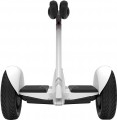Max. load
The maximum rider weight that the device can support (including the weight of a backpack, bag and other things carried on oneself; this is especially important to remember if the weight of the person himself is close to the maximum allowable). If the permissible load is exceeded, the transport not only loses efficiency but can also break down at any time. Therefore, it is impossible to ignore the prescriptions for weight anyway.
Range
The average distance that can be driven on a single battery charge. Usually, the range is indicated with some overestimation — based on a low (optimal from the point of view of energy consumption) speed, uniform movement on a flat surface, etc. Therefore, the actual battery life may be somewhat less. Nevertheless, this parameter is quite suitable for comparing different models with each other.
Thanks to the development of technology, the range in modern self-balancing vehicles can reach
several tens of kilometers.
Clearance
Clearance is the distance from the lowest point of the hull to the ground; in other words, this is the largest size of an obstacle on the road (in height), that the device can pass under itself. High clearance contributes to cross-country ability. However, it requires large-diameter wheels and, accordingly, an increase in motor power, which in turn affects the weight and price of the device. In addition, self-stabilizing transport is designed primarily for urban use, with driving on a flat surface. Therefore, even in most models, the clearance does not exceed 150 mm, and in some devices, it is only 30 mm.
Battery capacity
Battery capacity of the device in milliamp-hours (mAh)
This parameter characterizes the amount of energy that the battery can store. The
higher the number the more energy the battery stores, respectively, the greater the range (see above) and the more time it will take to charge. However, mAh is a popular, but not very reliable unit of power measurement: the actual amount of stored energy depends not only on the “milliamp hours”, but also on the battery voltage (and it can vary greatly in different models). The actual battery life strongly depends on the power consumption of the unit (determined primarily by engine power). This means that only models with similar performance characteristics and the same battery voltage can be compared with each other in this indicator. And when choosing, it’s easier to focus on more practical indicators — first of all, the range.
Battery capacity
The battery capacity of the device in watt-hours (Wh).
In general, capacity shows the amount of energy that a battery can store. The higher the number, the more energy the battery stores, respectively, the greater the range (see above) and the more time it will take to charge. Note that although watt-hours are used to designate power much less frequently than milliamp-hours (see above), this designation is more reliable, because when evaluating capacity, in this case, the battery voltage is also taken into account (as opposed to counting in mAh). This makes it easy to compare batteries of different voltages. At the same time, do not forget that the energy consumption of different models can also be different, and battery life is easier to evaluate by the directly claimed range.
Power
The power of the motor installed in the device. For models with two electric motors, this paragraph usually indicates their total power.
This parameter is one of the most critical for self-balancing transport. On the one hand, powerful motors improve the efficiency of balancing (especially with the large weight of the rider), allow you to reach high speed, effectively overcome bumps in the road and climb hills. On the other hand, they weigh a lot, are expensive and require capacious batteries to ensure a decent range (which further affects the weight and price of the entire unit). Therefore, motor power, usually, directly depends on the price category of a particular model.
In fact, the more powerful the motors, the better, and the question of choice for this parameter depends primarily on the price.

